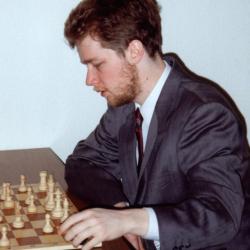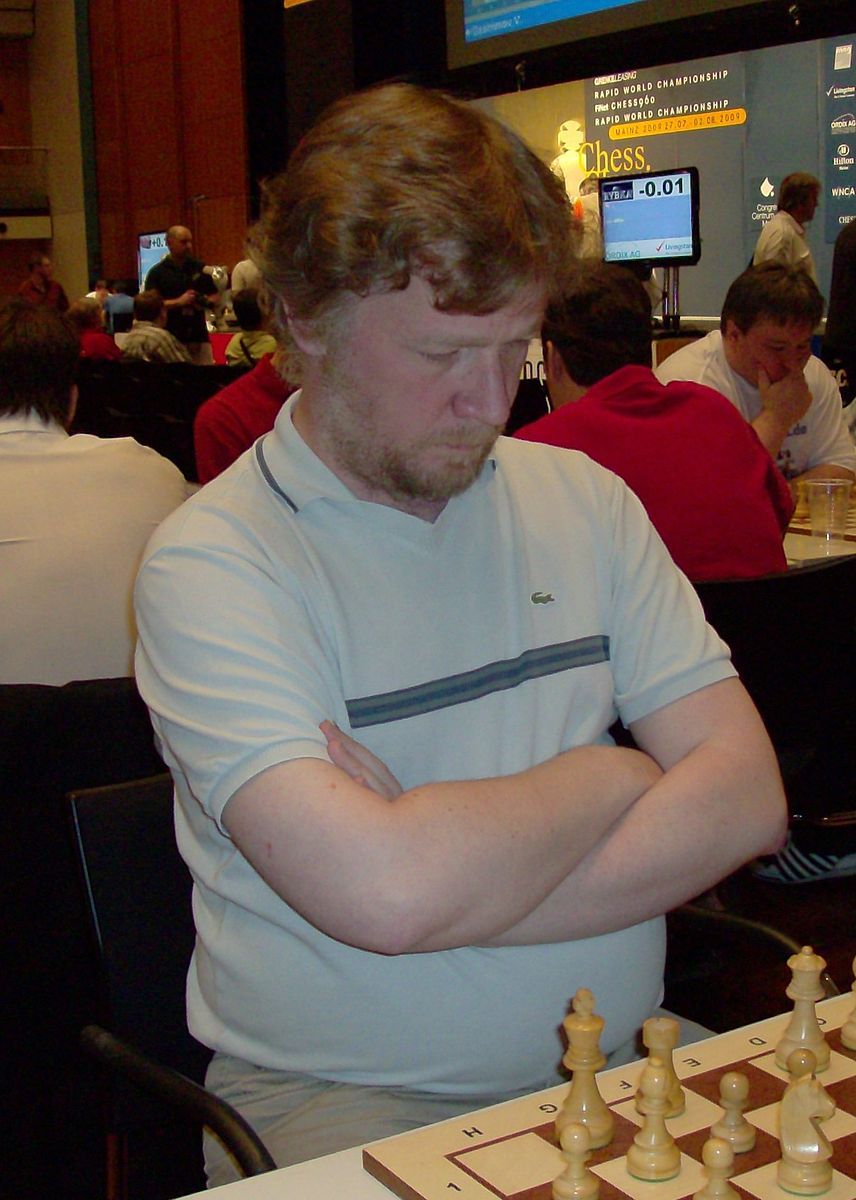GM Alexander Khalifman

Bio
Alexander Khalifman is a Russian grandmaster. He is a former Soviet youth champion, the former European U-20 champion, a member of multiple gold medal-winning Olympiad Russian teams, and the former Russian champion.
In 1999 Khalifman became the FIDE world champion. He is also a celebrated chess author and has coached several strong players such as GM Vladimir Fedoseev and GM Rauf Mamedov.
- Early Career
- Grandmaster
- Russian Champion
- 1999 FIDE World Championship
- Life After The World Championship
Early Career
Khalifman started playing chess at the age of six. His first major success came when he won the 1982 Soviet Union Youth Championship. He won his second Soviet Youth Championship in 1984 and the European Under-20 Championship in 1985. Khalifman became an international master in 1986.
Grandmaster
Khalifman earned the grandmaster title in 1990 at the age of 24 after winning the New York Open. He finished in clear first place with a 7/9 score ahead of many strong players, including GMs Gata Kamsky, Yasser Seirawan, and former world champion Mikhail Tal.
Khalifman also won the 1990 Groningen tournament, and at the 1990 Manilla Interzonal tournament he scored 7.5/13, half a point behind the 11 qualifiers—narrowly missing a spot in the world championship cycle.
In this game from this time, Khalifman shocks Seirawan in a miniature by taking control early as his opponent plays an early sideline in the Caro-Kann. In a worse position, Seirawan plays 20...Qa5, either overlooking or underestimating Khalifman's reply:
The thunderbolt-like exchange sacrifice 21. Rxe8 sets up an unavoidable mating net, and Khalifman ends the game quickly afterward—a very convincing attack!
In 1992 Khalifman represented Russia for the first time in the Olympiad (Russia won the gold medal). In 1993 he won the Ter Apel scoring 3.5/5 alongside GM Rafael Vaganian, ahead of four strong grandmasters.

In 1994 he won the Chess Open of Eupen with an outstanding 6.5/7 score ahead of a field of talented grandmasters and masters. The following game from 1994 displays another of Khalifman's attacking masterpieces.
His opponent, GM Gregory Serper, played ambitiously in the opening, and a double-edged and unbalanced position is reached early. By move 11, White has a developmental advantage and a weakened kingside for Black as compensation for a pawn. On move 17, Khalifman regains the pawn and retains his other pluses. After 22.Rf4 all of White's pieces are on the fourth or fifth ranks:
A few moves later, the rook on f4 has been rerouted to b2, and the constellation of White's pieces on the queenside is both aesthetically pleasing as well as deadly. The final misstep of the game is 27...Nxd7 that allows a beautiful and memorable mate in five—a fitting end to this gem of a game!
In 1995 Khalifman won the St. Petersburg Open and had a good showing at the Linares tournament, where he placed fifth out of 14 participants. He finished behind GMs Vassily Ivanchuk, Anatoly Karpov, Alexei Shirov, and Veselin Topalov but finished ahead of nine world-class grandmasters. Khalifman was beginning to climb the highest ladders in chess, which soon became apparent.
Russian Champion
Khalifman won the 1996 Russian Championship with an 8/11 score and finished in clear first place ahead of a strong field of 52 master participants (including 34 grandmasters).
In this example from the tournament, Khalifman uses his bishop pair with devastating effect against the legendary GM Evgeny Sveshnikov. Khalifman's opponent accepts the Catalan gambit pawn and a second pawn on move 14. Khalifman then wins the bishop pair on move 17 and capitalizes three moves later with 20.Ra6:
The bishops are raking the board, and Black has no answer for the pinned bishop on d6. Sveshnikov decides to give up the queen instead of being down a full piece and being stuck in a bind. This decision doesn't solve any problems, and after the smoke clears Khalifman is just up a queen for a rook. This is another great example of how Khalifman gives up material and navigates the materially-imbalanced position almost perfectly.
Khalifman continued his success and won the St. Petersburg Championship in 1996 and 1997, and he also won the Grandmaster Tournament in St. Petersburg that year. He continued his strong form by winning the 1997 Aarhus tournament as well as the 1997 and 1998 Bad Wiessee open tournaments.
In this game from 1997, Khalifman unleashes a devastating attack from the black side of a Ruy Lopez Marshall attack. Both players follow theory for a while until a misstep by White allows the shot 19...Nf4:
A few moves later, Black's attack is in full swing. Khalifman conducts the attack well and offers a piece on move 25, which his opponent should have declined (but doesn't). After 26.Qxd6, Khalifman finds another pretty shot with 26...Rf2! In the tactical sequence that follows, White gives up his queen for a rook and bishop. Unfortunately, White is helpless against the powerful passed pawn on f2, and Khalifman again shows his expertise in materially imbalanced positions.
His growth in the late 1990s is notable, and his largest chess accomplishment would happen in the final year of the 20th century.
1999 FIDE World Championship
The 1999 FIDE World Championship was a knockout tournament with 100 participants. In the first round, Khalifman defeated GM Dibyendu Barua; in the second round, he faced the fourth-seeded Kamsky. Khalifman dispatched him and then GM Karen Asrian in the third round. In the fourth round, he beat former challenger GM Boris Gelfand to reach the quarterfinals (top eight). Khalifman then defeated the legendary GM Judit Polgar and was up against GM Liviu-Dieter Nisipeanu in the semifinals.
In the only decisive game from the Khalifman-Nisipeanu semifinal, Khalifman played the white side of a Catalan. He had a promising position directly out of the opening, and Nisipeanu went for an early piece sacrifice with 15...Nxc5. A few moves later, Nisipeanu got a third pawn for his piece and had a pleasant-looking position on the surface—until Khalifman's 20.Nce4 shattered the illusion.
Khalifman's play was convincing and after 24.Nf7+, Nisipeanu had to give up his queen in a position with a few hanging pieces. Once the dust settled, Nisipeanu had a rook and knight for a queen, and Khalifman converted easily. This victory meant that he would advance to the 1999 FIDE world championship final where he would face GM Vladimir Akopian.
Khalifman won game one of the final as well as the fourth game (losing game three) and won by a 3.5-2.5 score to become FIDE world champion.

When Khalifman became the FIDE world champion, he was ranked 44th in the world. After the tournament, Khalifman said, "Rating systems work perfectly for players who play only in round-robin closed events. I think most of them are overrated. Organizers invite [the] same people over and over because they have the same rating and their rating stays high."
Rating systems work perfectly for players who play only in round-robin closed events. I think most of them are overrated.
— GM Alexander Khalifman
Life After The World Championship Title
After becoming the FIDE world champion, Khalifman participated in the 2000 Linares tournament where he finished with 4.5/10 behind the winners, GMs Vladimir Kramnik and Garry Kasparov. He shared third place with GMs Shirov, Viswanathan Anand, and Peter Leko. Khalifman won the 2000 Hoogeveen tournament ahead of GMs Jan Timman, Alexander Galkin, and Polgar. He was also a member of the gold medal-winning Russian team at the 2000 Chess Olympiad.
Khalifman attempted to defend his FIDE title at the 2000 FIDE world championship knockout tournament. He was the 21st seed and defeated GMs Christopher Lutz, the fifth-seeded Leko, and Rafael Leitao to reach the quarterfinal. Khalifman lost to the top-seed and eventual winner, Anand, in the top eight.

In October 2001, Khalifman achieved his peak rating of 2702, achieving the unofficial super-grandmaster rating. He returned as a team member for the gold medal-winning Russian team at the 2002 Olympiad and took fifth place with a 7.5/13 score at the 2002 Corus Group A tournament behind GMs Evgeny Bareev, Alexander Grischuk, Michael Adams, and Morozevich but ahead of nine world-class grandmasters.
Here is Khalifman's victory over the 2002 Corus A winner, Bareev, from this tournament—a 20-move miniature! In this game, Khalifman gives up not one but two pawns very quickly. After 17.Rhg1, the position is balanced despite the material deficit.
In the position above, Bareev miscalculates and plays 17...Nf4?, and Khalifman ends the game three moves later. The final move, which chases away the queen to make 21.Rh5! possible, is particularly memorable as a display of what pieces can do when they are all working together harmoniously for a singular goal: checkmate.

Khalifman continued playing but mostly in larger open tournaments and team competitions. In 2010 he tied for first at the Minsk Open and also won the Bad Wiessee open (for the third time). He wrote many chess books from 1994 through 2011, mostly focusing on world champions and opening repertoire series. He has been coaching GM Fedoseev since 2011 and has also worked with Mamedov. In 2012 he tied for fourth place at the Aeroflot open with 6/9 alongside GMs Fabiano Caruana, Dmitry Andreikin, and others.
Still a strong grandmaster, Khalifman tied for 11th place at the 2018 Aeroflot tournament with 5.5/9. He scored 6.5/9, one point behind the winners, at the 2019 Chigorin Memorial.


